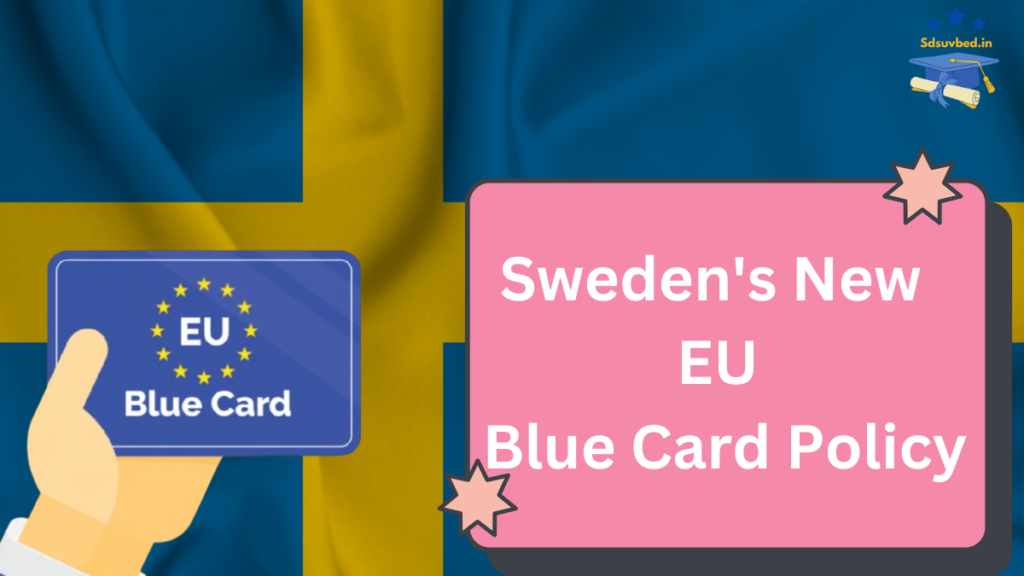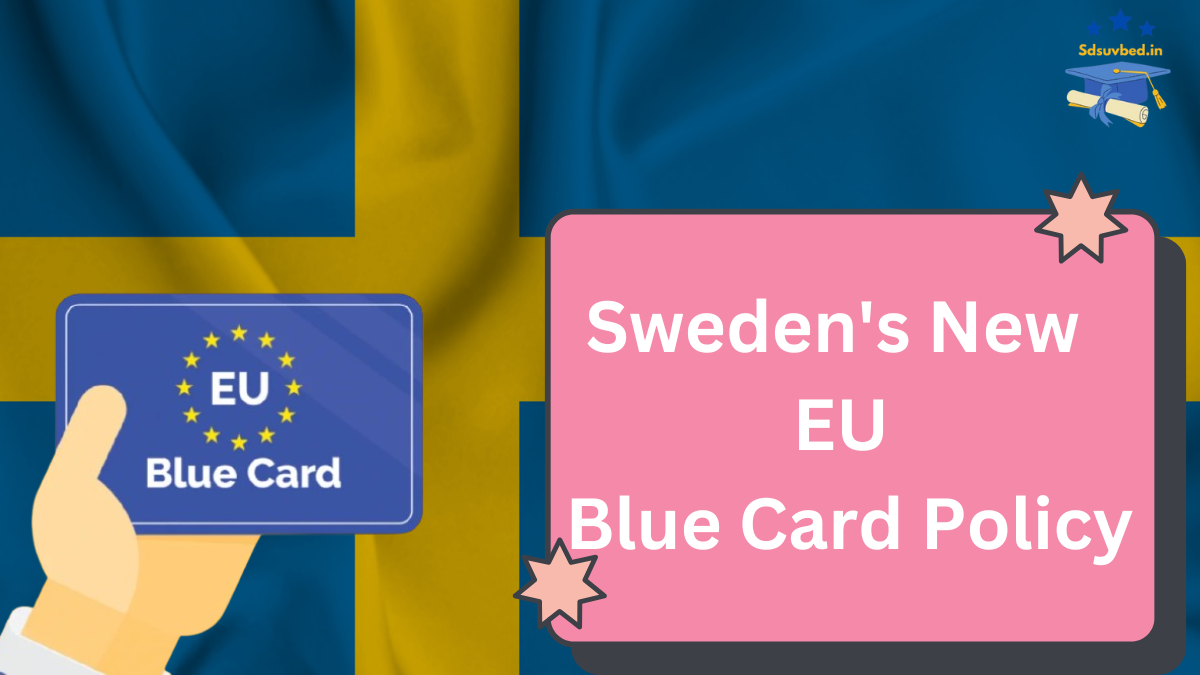Starting January 1, 2025, Sweden is rolling out updated EU Blue Card regulations, making it easier for highly skilled professionals from non-EU countries to live and work in the country. These changes are designed to attract global talent in fields like IT, healthcare, engineering, and finance by reducing salary thresholds, easing employment contract requirements, and improving job flexibility.
If you’re considering a move to Sweden, this guide will walk you through the new eligibility requirements, application process, and long-term benefits of the updated EU Blue Card program.

Key Features of Sweden’s Updated EU Blue Card
| Feature | New Policy (Effective 2025) |
|---|---|
| Minimum Salary Requirement | 1.25x Sweden’s average salary (≈ SEK 49,875 per month) |
| Employment Contract Duration | Minimum 6 months (previously 12 months) |
| Job Flexibility | Can switch jobs with a simple notification to the authorities |
| In-Country Application | Allowed for certain residence permit holders and existing EU Blue Card holders in the EU |
| Processing Time | Estimated 3-4 months |
| Pathway to Permanent Residency | Eligible after 33 months (or 21 months with Swedish language proficiency) |
| Family Benefits | Spouses can work without restrictions |
| Official Authority | Swedish Migration Agency |
With these changes, Sweden is actively opening doors to international talent, making it an attractive destination for skilled professionals worldwide.
Understanding the EU Blue Card
The EU Blue Card is a work and residence permit specifically designed for non-EU professionals with specialized skills. Similar to the U.S. H-1B visa, it allows high-skilled workers to move to Sweden (or other EU countries) with benefits such as easier residency applications, flexible job opportunities, and family reunification rights.
Why Choose Sweden?
Sweden stands out as a top destination due to:
- A booming tech sector with global firms like Spotify, Ericsson, and Volvo
- Strong work-life balance and a high quality of life
- Opportunities in key industries such as healthcare, engineering, and finance
- An inclusive and innovative work culture that supports international employees
If you’re a skilled professional looking for career growth and a great living environment, Sweden should be on your radar.
Major Updates to the EU Blue Card Rules in Sweden
1. Lower Salary Threshold
- The minimum salary requirement has been reduced from 1.5 times to 1.25 times the country’s average salary.
- In 2025, this means earning at least SEK 49,875 per month.
Example: A software engineer receiving a job offer of SEK 55,000/month now qualifies under the new rules.
2. Shorter Employment Contract Requirement
- Previously, applicants needed a minimum 12-month contract. This has now been lowered to 6 months.
Example: If you secure a 7-month contract at a Swedish research institute, you can now apply for a Blue Card instead of needing a full-year job offer.
3. Easier Job Changes
- Earlier, EU Blue Card holders had to reapply for a new card when changing jobs.
- Now, job changes only require notifying the Swedish Migration Agency—no need for reapplication.
Example: If you transition from one tech company to another in Sweden, you simply notify authorities instead of restarting the application process.
4. Expanded In-Country Applications
- If you already hold a Swedish residence permit (e.g., a student visa) or have an EU Blue Card from another EU nation, you can now apply without leaving Sweden.
Eligibility Criteria for Sweden’s EU Blue Card (2025)
To qualify, applicants must:
- Hold a university degree OR have 5+ years of professional experience in a relevant field.
- Have a valid job offer from a Swedish employer.
- Meet the minimum salary requirement (SEK 49,875/month).
- Work in an occupation classified as highly skilled under Swedish labor laws.
- Possess health insurance covering their stay.
- Have no security or public health risks.
Also Read: Key Stocks to Monitor Ahead of the Union Budget 2025: Investor Strategies and Insights
How to Apply for the EU Blue Card in Sweden: Step-by-Step
Step 1: Secure a Job Offer
- You must have a confirmed job offer from a Swedish employer meeting the salary threshold.
Step 2: Gather Required Documents
- Valid passport
- Employment contract (minimum 6 months)
- Proof of qualifications (degree/work experience documentation)
- Salary details matching the requirement
- Health insurance certificate
- Proof of accommodation in Sweden
Step 3: Submit an Online Application
- Applications are processed via the Swedish Migration Agency’s online portal.
- Your employer must also provide details about your employment.
Step 4: Pay the Application Fee
- Standard fee: SEK 2,000
- Payment via bank transfer or credit card
Step 5: Attend a Biometric Appointment
- If applying from abroad, visit the nearest Swedish embassy or consulate for fingerprinting and a photo.
Step 6: Wait for Processing
- Application processing time: 3-4 months.
- Check your status online.
Step 7: Receive Your EU Blue Card & Move to Sweden
- Once approved, your EU Blue Card serves as both a work permit and a residence permit.
- You’re now ready to relocate and start your career in Sweden!
Also Read: UK Visa Policy Changes: New Financial Requirements Effective 2025
Final Thoughts
Sweden’s revamped EU Blue Card program offers an excellent opportunity for highly skilled workers to build a career in one of the most innovation-driven economies in the world. With a simplified process, lower salary thresholds, and greater job flexibility, there has never been a better time to consider working in Sweden.
FAQs
1. Who can apply for the Sweden EU Blue Card?
Highly skilled professionals with a university degree or 5+ years of relevant work experience who have a valid job offer in Sweden can apply.
2. What are the benefits of the EU Blue Card?
Holders can work and live in Sweden with a fast-track route to permanent residency, job flexibility, and unrestricted work rights for their spouses.
3. How long does the application process take?
It typically takes 3-4 months, depending on the applicant’s profile and document verification.
Click here to learn more
Pari is a passionate writer known for captivating stories that blend imagination and reality. Inspired by travel, history, and everyday moments, Pari crafts narratives that resonate deeply with readers.

